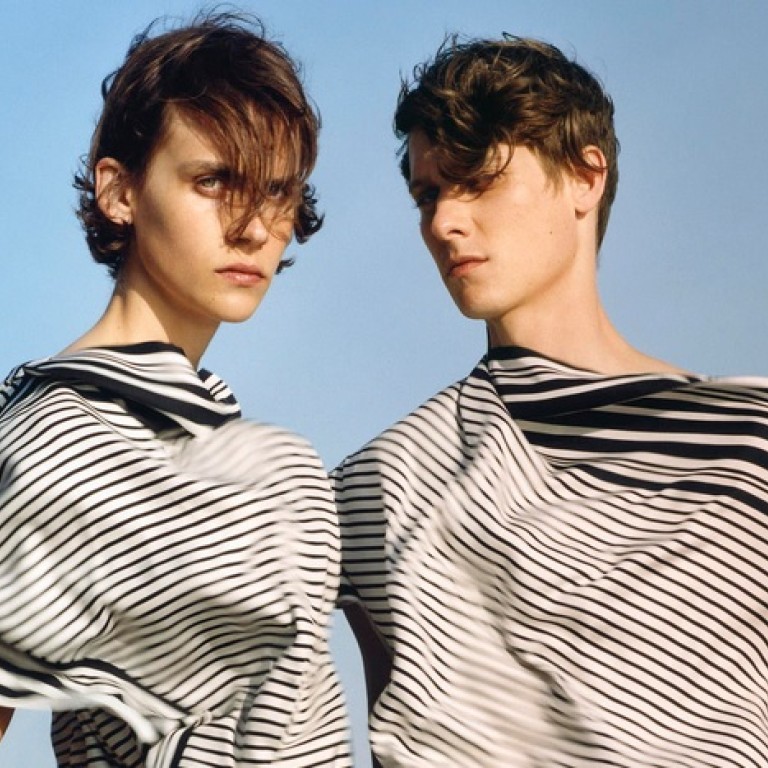
Unisex fashion is all the rage, but will it be accepted into the mainstream?
Designers are taking the androgynous trend one step further by launching unisex collections that promote self-expression over gender, writes Divia Harilela
Blurring the gender lines wasn't always as hip as it is today. Back in the 1930s and '40s, when Hollywood starlets such as Marlene Dietrich and Katharine Hepburn first pulled on wide-legged trousers and mannish button-down shirts, the look was considered scandalous and decidedly unfeminine.
Fast forward to the '90s, and androgyny officially became mainstream, thanks to the rise of feminism and pioneering designers such as Helmut Lang and Jil Sander.
In the first decade of the new millennium, girls dressing like boys became a recurring fashion trend, as women continued to "borrow" items from men's wardrobes, lending to the popularity of items such as "boyfriend jeans" and "boyfriend jackets".

Today, fashion is more interchangeable than ever, with men dressing in womenswear (see Kanye West in Céline) and vice versa. As such, a new category has emerged as many designers build entire brands based around the concept of unisex garments.
Unlike the androgynous look, which sees both sexes mix and match popular items from each other's wardrobes, unisex dressing doesn't discriminate, and eliminates gender norms.
According to buyers, the concept has become more popular thanks to the re-emergence of minimalism on the fashion scene.
"For sure, the minimal trend has led to the rise of more unisex silhouettes. And after a few seasons of prints and feminine touches, it's time to go back to basics, including boxy, less fitted and simpler cuts. This is very close to the unisex style," says Tracey Cheung, head of merchandising women's wear at I.T Apparels.

"This generation is more open minded and not concerned so much about gender. Today, both sexes will buy items they like, regardless of whether they are categorised as men's or women's," he says, citing brands such as Céline, Dries Van Noten and Thom Browne as cross-gender favourites.
What makes unisex fashion so appealing and relevant today is that it eschews trends completely. Instead, it is used as a means of self-expression and encourages the wearer to experiment with their personal style without being bound by the constraints of gender. It's also relatively easy to wear.
"Usually, unisex brands will do a wider size range in order to accommodate women's and men's sizes. In general, it is easier for customers to wear, as the bulk of the merchandise are usually less fitted, and require a less than perfect body shape," says Cheung.
The biggest proponent of unisex fashion in the industry is Paris-based Canadian designer Rad Hourani, who founded the first unisex brand back in 2007.

"It doesn't make sense to me to limit things, which is why I studied male and female bodies to create a canvas that can fit both.
"It has always been relevant to for me as it's about the yin and yang in all of us. I'm not interested in trends, as they fade," he says.
Hourani's architectural shapes come in an all-black palette, although the final look is bold without looking contrived or overdone. Last year he took the concept one step further by launching another first: a haute couture unisex collection featuring more elevated fabrics and handcrafted details.
His latest autumn-winter collection features his signature sculptural shapes, including kimono-wrap jackets and multicollared trenches made from black fabric infused with silver threads and sequins.
"My process is always based on my original unisex canvas, and that starts with my main rules: genderless, timeless, seasonless, ageless, straight, symmetrical, and involving long shapes," he says.
"Then I sketch a graphic shape that is not limited to becoming only a garment. From there I continue the evolution of the same first sketch. I want my shapes to come alive through the movement of the wearer."
Another following suit is British designer J.W. Anderson. Anderson's collections are very much rooted in menswear - he started designing men's first in 2008, but launched a women's collection in 2010.

"I find it very difficult to see the boundary between women's wear and menswear. It's bizarre the ways in which society reacts; they find it difficult to comprehend seeing parts of the body on a man. I think it's fascinating," he recently told Dazed Digital.
Anderson is taking this cool concept of interchangeability and applying it to the world of luxury. His first men's collection for Spanish brand Loewe, which was showcased in Paris in June, included modern separates such as oversized draped tops, long tunics, cuffed trousers and scarf tops.
The accompanying campaign images feature each style worn by androgynous-looking male and female models to drive the point home.
It seems that unisex collections are only set to grow. The latest to jump on the bandwagon is Saint Laurent, where Hedi Slimane has created his first unisex collection, Psych Rock, featuring embellished ponchos and capes, skinny jeans and cowboy boots inspired by music and youth culture.
But the question is, will there ever be a time when unisex fashion will be accepted into the mainstream?
"It's difficult to say for now. It's a matter of supply and demand. Right now we have a comparatively small proportion of customers who are buying into the unisex collection, although I can see that there is a consistent demand," says Cheung.
"If there are more designers presenting unisex labels, this will arouse more interest among customers and encourage them to explore it further."

